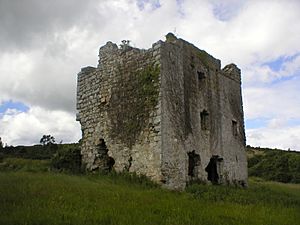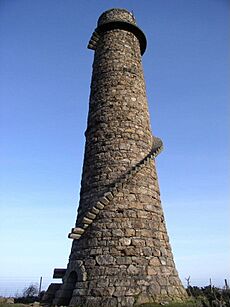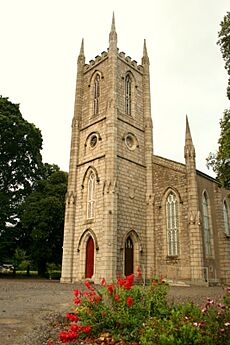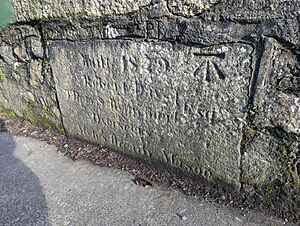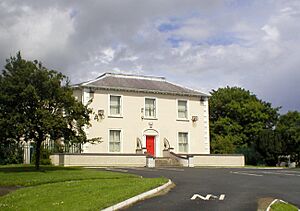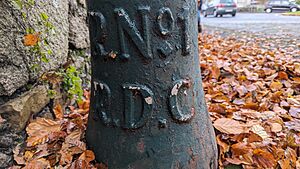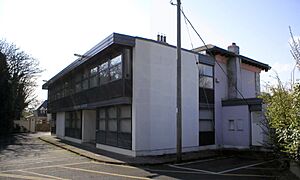Shankill, Dublin facts for kids
Quick facts for kids
Shankill
Seanchill
|
|
|---|---|
|
Suburban
|
|

Shankill, County Dublin
|
|
| Country | Ireland |
| Province | Leinster |
| County | County Dublin |
| Local government area | Dún Laoghaire–Rathdown |
| Area | |
| • Suburban | 6.4 km2 (2.5 sq mi) |
| Elevation | 29 m (95 ft) |
| Population
(2016)
|
|
| • Urban | 14,257 |
| Time zone | UTC+0 (WET) |
| • Summer (DST) | UTC+1 (IST (WEST)) |
| Eircode routing key |
D18
|
| Telephone area code | +353(0)1 |
| Irish Grid Reference | O249220 |
Shankill is a lively suburb located in Dublin, Ireland. It sits on the southeast side of County Dublin, very close to the border with County Wicklow. The area is part of Dún Laoghaire–Rathdown and had about 14,257 people living there in 2016. Shankill stretches from the coast, between Loughlinstown and Bray, and goes inland towards the Dublin Mountains. It shares borders with places like Rathmichael, Loughlinstown, Killiney, Ballybrack, and Bray.
| Top - 0-9 A B C D E F G H I J K L M N O P Q R S T U V W X Y Z |
What's in a Name?
The name Shankill comes from the Irish words Sean-Chill. This means "Old Church".
Exploring Shankill's Geography
The area we call Shankill today is mostly near the coast. However, the original townland of Shankill was further inland, closer to Puck's Castle. Shankill covers an area of about 6.5 square kilometers. To the west, you'll find Carrickgollogan Hill, which is 278 meters tall. The old Ballycorus Leadmines are to the northwest. To the north are Loughlinstown and Killiney, and to the south is the town of Bray.
A Journey Through Shankill's History
Ancient Times in Shankill
Shankill has many old historical sites. These include ancient forts called ráths and stone monuments known as cromlechs.
Around the year 1230, the owner of Shankill, Archbishop Luke, ordered many forests to be cut down. Courts for serious crimes were held in Shankill during this time. To keep out the native Irish, parts of the area were protected by barriers and strong gates. About a century later, the manor of Shankill was attacked and destroyed by the native Irish. A large group of soldiers was then brought in to protect the area. The Irish were kept out, and the land was later used for grazing animals.
Shankill in the Middle Ages
The Lawless family played a big part in Shankill's history. In 1408, members of this family took control of Shanganagh. By 1480, many Lawless family members lived in Shankill.
Between 1400 and 1600, several strong buildings were constructed. You can still see parts of them today in Shankill and Rathmichael. These include Shankill Castle, Shanganagh Castle, and a strong house called Puck's Castle. The Walsh family, who became important in the 1500s, built even more defensive structures in Shankill.
From 1640 onwards, conflicts led to more peaceful times. This allowed the land to be used more for farming. Around this time, Shankill became part of the Rathmichael parish. The Walsh family left Shankill mainly because of a law that changed who owned land. After this, the Lawless families got their land back for the third time. The last Lawless died in 1795. The land then went to Sir William Domvile, who lived in Loughlinstown House nearby.
Shankill in the 1800s
The Domvile Family's Influence
Shankill and Rathmichael were owned by Sir Charles Compton William Domvile (1822–1884). Domvile was a very strict landlord. He wanted to change how the land was used. At that time, Shankill was a small farming village. Domvile planned to build large, fancy Georgian-style houses, squares, and streets. He hoped this would make the area attractive for wealthy people from Dublin city.
During Domvile's time, new roads and water pipes were built. However, Domvile often acted unfairly with his tenants. His own debts grew because he was paying for two big building projects in Shankill and Santry. This eventually led to him losing all his money.
Domvile's actions caused the population of Shankill and Rathmichael to drop by half in the 1860s. He forced over 100 families out of their homes. Many of these families were very poor. They had to try to get new rental agreements at very high prices. Many who were forced out ended up in the local workhouse, which is now Loughlinstown Hospital.
The New Shankill Village
Benjamin Tilly, a landowner next to Shankill, helped some of the families who had been forced out. He gave them small plots of land. Tilly's land was near the border with Shanganagh. So, the new homes along Shanganagh Road became known as 'Tillystown'. By 1871, there were over 60 houses there. Around the early 1900s, this village became known as Shankill itself.
In 1911, a piece of land west of Shankill, called 'New Vale', was developed. Small cottages were built there for workers.
Shankill in the 1900s and 2000s
Shankill used to have large farms divided into small plots for farmers. It also had grander estates with beautiful country houses. Many of these houses still stand today. Over the years, many large housing estates have been built on these lands. More land has also been sold to builders. They have constructed more homes, often closer together than the older estates from the 1970s.
Local Landmarks and Interesting Spots
Shankill has several old and interesting places. You can find ruins of churches and standing stones. There are also remains of castles and defensive buildings. These include Puck's Castle, Shankill Castle, Shanganagh Castle, and a Martello Tower.
Some houses are special because of their design. Clontra is a coastal mansion with a Gothic style. Crinken Castle House and Shanganagh House are also notable. Clontra was designed by famous 19th-century architects, Sir Thomas Newenham Deane and Benjamin Woodward.
The local library used to be a courthouse. It was built in the Victorian style with granite and mock Tudor features. You can also find some interesting follies, like a fake round tower made of red brick at Castle Farm.
Evidence of old industries includes the tall chimney from the lead-mine at Ballycorus. Another interesting feature is the 'upside down' houses near the old Harcourt Street railway line bridge. These houses have their guest rooms downstairs and their kitchen and living room upstairs. Shankill was once connected by the original Kingstown-Bray train line. This line is now very close to the sea in some places. A wall was built along the coast to try to stop erosion, and you can still see parts of it on the beach. An old medieval village called Longnon was once located near Quinn's Road beach. However, it was washed away by coastal erosion.
Important Buildings
Ballycorus Leadmines
This was a place where lead ore was melted. It has a mile-long stone pipe and a granite chimney on Carrickgollogan hill. You can see this chimney from many parts of southeast Dublin.
Carnegie Library
This library was built in 1912. It has a Tudor-style design and was designed by architect R. M. Butler.
Clontra
This is a Gothic mansion designed in 1860. It sits on 15 acres of parkland by the coast.
Dorney Court
This beautiful Victorian house was built around 1832. It was taken down in 1984. The Shankill Garda Station (police station) is now on its site. Some large Sequoia and Scots Pine trees still grow on the grounds.
Puck's Castle
This 'castle' is actually a strong house built in the late 1500s. In 1690, King James II and his army found safety here after the Battle of the Boyne. One story says the castle is named after a ghost or puca that lived there. In 1867, a local girl disappeared near the castle. Her name was Jane Eleanor Sherrard. She left her home to pick flowers and was last seen near the castle. No one knows what happened to her.
Rathmichael Church
This church was built in 1860. It was designed in the Hiberno-Romanesque style.
Shanganagh Bridge (1829)
This bridge is at the meeting point of Commons Road and Shanganagh Road. It has an old inscription that says: "Built 1829 - Robert Day Thomas Bourchier Esq's - Overseers Myles Bready - Mason".
Shanganagh Castle (1408)
This castle was built in 1408 by the Lawless family. It is located near Mill Lane. The family lived there until 1763. The castle was badly damaged by a fire in 1783. Only small parts of it remain today.
Shanganagh Castle (18th century)
Several kilometers from the older Shanganagh Castle, a large mansion was built in the late 1700s. It was on a big piece of land that reached the border of Shankill with County Wicklow. From 1969 to 2002, it was used as an open prison for young people. Now, the local government is developing the site. They plan to build over 500 homes, and the castle will be fixed up and reopened.
Shanganagh House
This large Georgian-style mansion was built around 1823. It was later called Shanganagh Park. It was bought by Dublin County Council in 1970. Today, it is a community centre and is surrounded by council houses built in the late 1970s.
Shankill Castle
This castle was built in 1229 by Archbishop Henry de Loundres. It is on the site of the ancient Shankill church. It is one of the oldest buildings still standing in the area.
Transportation and Infrastructure
Old Dublin & South East Railway Line
The Dublin and South Eastern Railway used to run along the coast. It connected Killiney and Bray.
Old Harcourt Street Line
This was a former railway line that ran from Dublin to Bray on an inland route. It closed in 1958.
The Modern D&SER Line
The coastal railway line was moved further inland because of erosion. This new line, called the "Shanganagh Diversion," opened in 1915.
Sanitation
A sanitation pole in Shankill Village has the letters 'R.No.1 R.D.C. 1911' on it. This refers to an old administrative district from 1899.
Local Life and Fun Things to Do
Learning in Shankill
Shankill has three primary schools:
- Scoil Mhuire (a Roman Catholic school)
- Rathmichael Parish School (a Church of Ireland school)
- Saint Anne's National School (a Roman Catholic school)
Places of Worship
Shankill has a Roman Catholic church called St Anne's. There are also two Church of Ireland (Anglican) churches: St James' at Crinken and Rathmichael Church.
Shopping and Services
Shankill has a convenience store, places to get takeaway food, barbers, pharmacies, and beauty salons. There is also a Lidl shopping center. The local credit union has an office on the main street, and there is a public library.
Sports and Outdoor Activities
Walking Trails
The Dublin Mountains Way starts on the main street in Shankill. This is a long walking path, 43 kilometers long, that goes across the Dublin Mountains to Tallaght.
Football
Shankill has local soccer teams, including Shankill FC. They have teams for both boys and girls.
Tennis
Shankill Tennis Club has a new clubhouse that opened in 2007. They also added indoor courts in 2016. The club is located at the corner of Quinn's Road and Corbawn Drive.
GAA (Gaelic Games)
The Shankill GAA Club started up again in 2013 after being closed for 20 years. As of 2021, the club has about 30 teams. They play Gaelic football, hurling, and camogie for both younger players and adults.
Sailing
Around 1877, a sailing club was formed at the end of Corbawn Lane. It was called the Shankill Corinthian Sailing Club. Members were from nearby houses. They sailed small open boats that could be pulled onto the beach by two people. The club lasted for over 10 years.
Awards and Recognition
In 2007, Shankill won the 'National Best Urban Village' award. It also won two other awards in the Irish Tidy Towns Competition.
Shankill, Dublin and Shankill, Belfast
Just like its namesake, the Shankill area in Belfast, Dublin's Shankill also has its own Falls Road. Sometimes, primary schools and community groups from both Shankills hold sports events. This helps to build friendships between the north and south of Ireland.
Getting Around Shankill
Bus Services
Dublin Bus routes 7b, 145, and 155 connect Shankill to the city center. Routes 84 and 84a link the area to Blackrock. The Go-Ahead Ireland routes 45a and 45b connect Shankill to Kilmacanogue and Dún Laoghaire. The Aircoach service to Dublin airport also stops on the main street.
Train Services
Shankill station is located between Rathsallagh Park and Corbawn Lane. It is the third-last stop on the southbound part of Dublin's DART line.
The original Shankill station was on the Harcourt Street railway line. This line opened after the Dublin and Wicklow Railway in 1854. The line closed in 1958. The current station in Shankill opened in 1977.
Luas (Tram) Services
The closest Luas stops (Green Line) are at Cherrywood and Brides Glen. These connect to Dublin city center. There have been ideas to extend the Green Line to Bray, which would pass through Shankill. However, these plans are not currently active.
Road Access
The N11 national route used to go through Shankill. Now, the M11 bypass has been built nearby. You can now reach Shankill using coastal roads, from the M11, or by a road at Crinken that goes over the M11.
Famous People from Shankill
- Bertie Messitt: An Irish record holder and Olympian who competed in the 1960 Rome Olympics.
- Des Cahill: A sports journalist for RTÉ.
- Eamon Gilmore: A former Tánaiste (Deputy Prime Minister) and former leader of the Labour Party.
- Pádraig Harrington: A professional golfer who has won three major championships.
- Michael Patrick Kelly (Paddy Kelly): A musician from the band The Kelly Family.
- George Morrison: A director of documentaries, including Mise Éire.
- Stephanie Roche: A footballer who was second in the 2014 FIFA Puskas Award for the best goal.
- Shane Ross: A business journalist and academic.
- Sandy Smith (born 1945): A former first-class cricketer.
Images for kids



